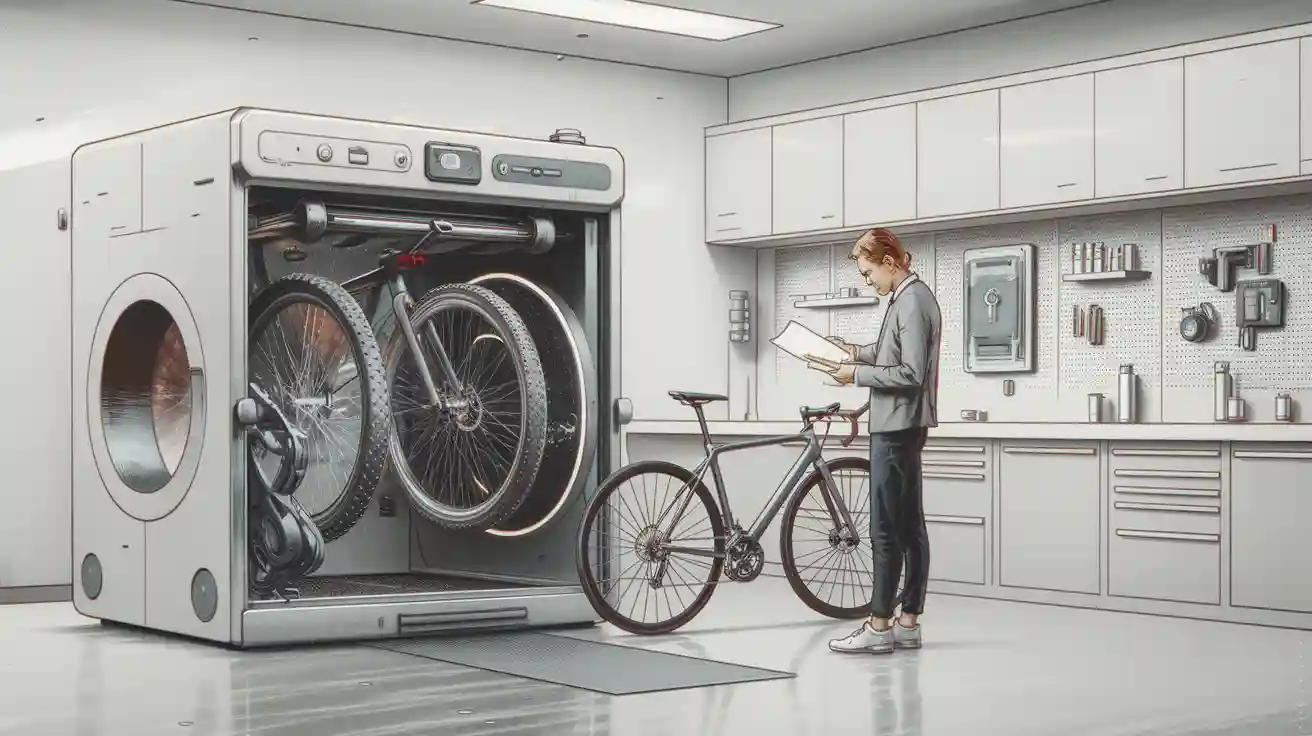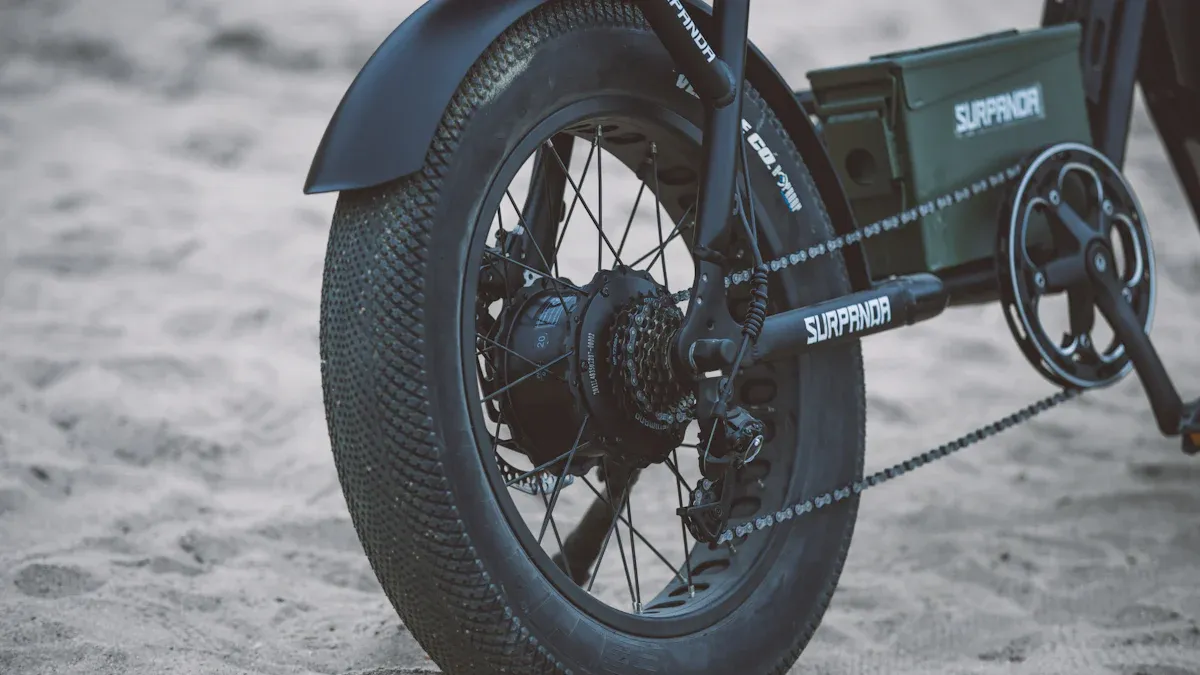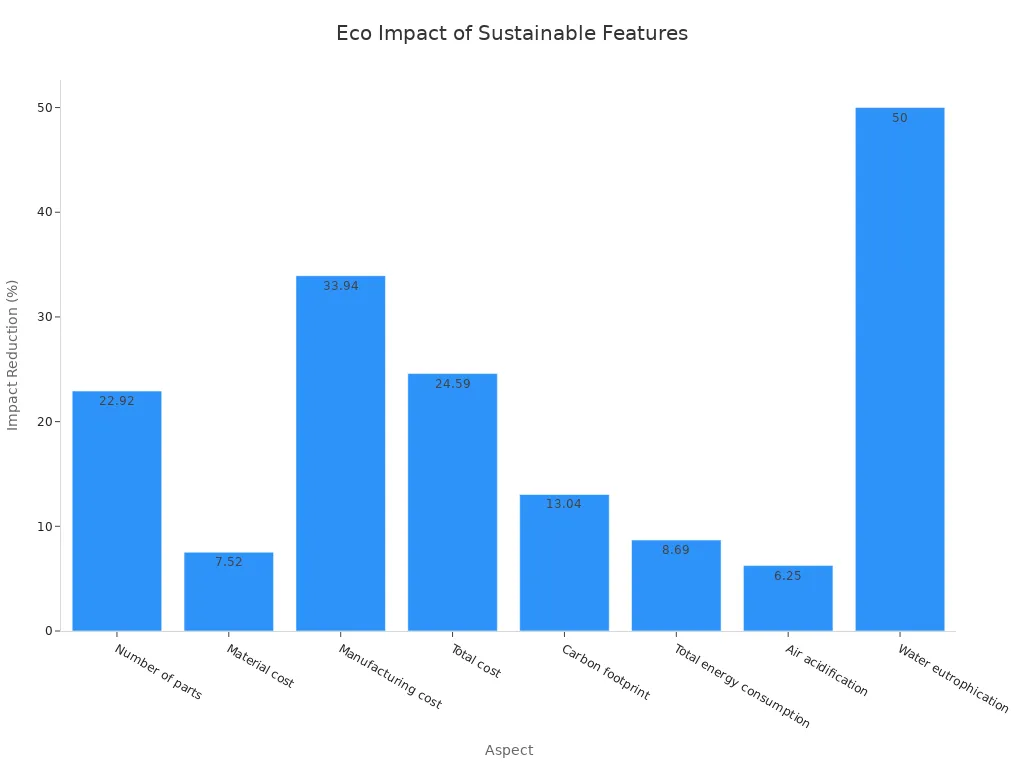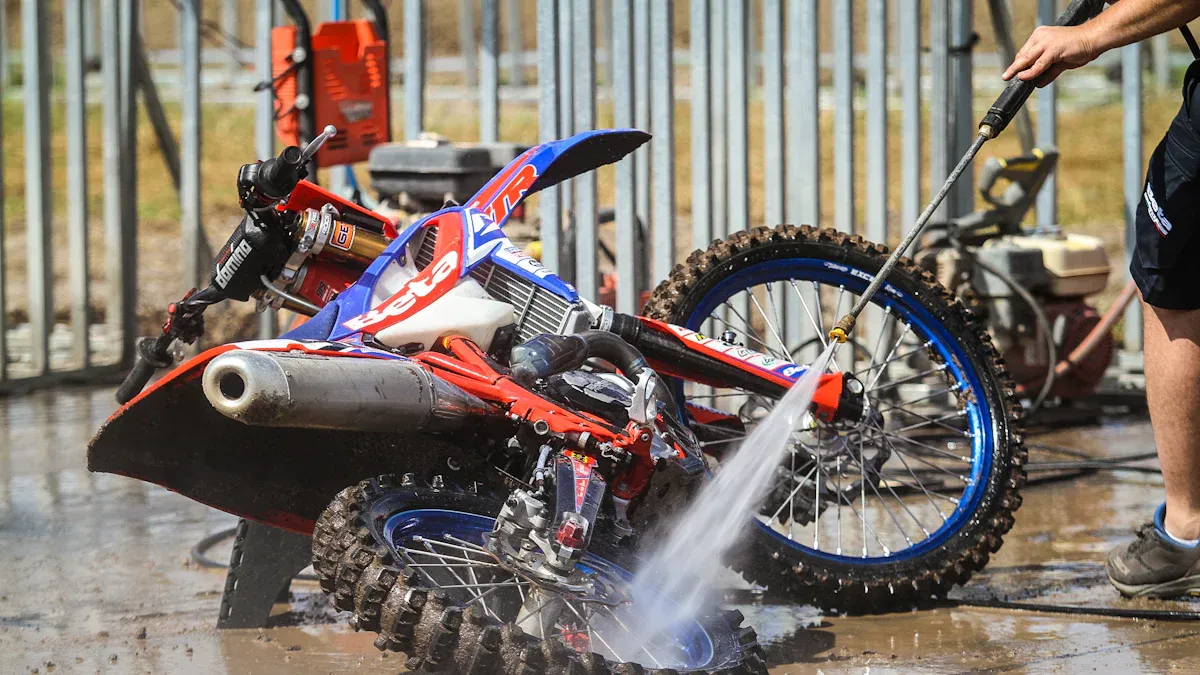
Choosing the best bike washing machine starts with knowing what your bike needs. You want a machine that fits your cleaning style and keeps your bike safe from damage. Many people now care about both their own needs and the planet. Check out these numbers:
Year |
Home Electronics Parts Sold |
Electro-Waste Saved (tons) |
Ecological Footprint per Person (gHa) |
|---|---|---|---|
2020 |
600,000+ |
1,500,000+ |
4.7 |
1975-1990 |
— |
— |
6.0 |
You see, more people choose products that save resources. So, when you pick a machine or even a foam gun for your bike, think about what matters most to you and the environment.
Key Takeaways
Pick a bike washing machine that matches how you clean. Make sure it fits your budget and space. It should also keep your bike’s delicate parts safe. Use low-pressure or manual cleaning to stop damage. This is very important for e-bikes and sensitive parts. Think about eco-friendly machines that use less water and energy. Use biodegradable detergents to help the environment. Choose the right machine type for your needs. Manual machines are good for home. Automatic ones work well for busy shops. Mobile machines are great for events. Pedal-powered machines are best for people who care about the planet. Take care of your machine and bike often. Clean, dry, and lubricate them to make them last longer and work better.
Choosing a Bike Washing Machine
Key Factors
When you start looking for the right bike washing machine, you want to focus on what matters most for you and your bike. Not every machine works the same way, and some features make a big difference in how well you can clean your bike. Here are the main things you should look for:
Criteria / Feature |
What It Means for You |
|---|---|
High-pressure washers can blast away dirt fast, but they might hurt delicate parts. Low-pressure systems are safer for fancy bikes and e-bikes. Some machines let you switch between both. Hand cleaning helps you reach tricky spots. |
|
Water Treatment |
Machines with filters, oil separators, and sludge collectors keep dirty water from polluting the ground or water supply. Some even recycle water, which is better for the environment and follows the rules. |
Material & Construction |
Stainless steel or protected aluminum lasts longer, especially if you keep your machine outside. Vandal-proof and compact designs work well for public places or if you need to move the machine. |
Mobility |
Stationary machines stay in one spot and handle more bikes. Mobile machines have their own tanks and pumps, so you can take them anywhere—great for events or if you move around a lot. |
Extra Features |
Look for things like detergent pumps, splash guards, dirt collectors, and settings you can change. These make cleaning easier and give you more control. |
Types of Systems |
Automatic machines save time and work well if you clean lots of bikes, but they cost more and might miss really dirty spots. Manual machines are cheaper and gentle, but you have to do more work. Mobile machines are flexible and gentle, but they hold less water and need you to do more. |
Environmental & Legal |
Machines with oil separators and filters help you follow the law and protect nature. Some use closed water systems to save water. |
Costs & Operating Expenses |
Automatic machines cost more to buy and fix. Manual ones are cheaper but need more effort. Water and power use depends on the type. |
Payment Systems |
If you want to use your machine for business, look for payment options like coins or contactless cards. This makes it easier for customers and helps you earn money. |
You can see that picking the right bike washing machine means thinking about how you want to clean your bike, where you will use the machine, and how much you want to spend. If you care about the planet, look for machines that recycle water or use less energy.
Tip: Always check if the machine fits your space and if you can move it easily. Some machines are heavy and need a fixed spot, while others are light and portable.
Safety and Bike Care
Keeping your bike safe during cleaning is just as important as getting it clean. Some machines use high-pressure water, which can damage sensitive parts like bearings, chains, or electric wires on e-bikes. You should avoid spraying these parts directly with strong jets. Instead, use low-pressure settings or hand tools for those areas.
Research on cleaning systems, like ozone-based sanitizers for bike helmets, shows that using the right amount of cleaning power is key. Too much can cause harm, but the right balance keeps things safe and clean. While these studies focus on helmets, the idea is the same for bikes. You want to control how much force and what kind of cleaner you use. This way, you protect your bike and avoid any damage.
When you clean your bike, always follow the instructions for your machine. Use gentle cleaners that won’t hurt the paint or parts. If your bike has special features, like electric parts or fancy gears, make sure the machine is safe for those. Some machines even have splash guards or special settings to help you avoid accidents.
Note: Never use a high-pressure washer right on your bike’s bearings, chain, or electric parts. Gentle cleaning keeps your bike running smoothly and helps it last longer.
Choosing the right bike washing machine and using it safely means you get a clean bike without any worries. You also help the environment and save money in the long run.
Types of Bike Washing Machines

Automatic
Automatic bike washing machines do most of the work for you. You put your bike inside and press a button. The machine uses brushes and water jets to clean it. Some even have dryers to finish the job. These machines save you time and effort. They are good for busy shops or places that rent bikes. Automatic machines can clean many bikes one after another. This makes them great for places with lots of bikes.
Tip: If you have a business, an automatic machine like Meitai’s commercial models helps you clean bikes fast.
Pros:
Quick and simple to use
Good for busy places
Cleans bikes the same way every time
Cons:
Costs more money
Needs a bigger space
Might not clean small, tight spots
Manual
Manual bike washing machines let you do the cleaning by hand. You use brushes, sprayers, or other tools. These machines cost less and are gentle on your bike. They are good for homes or small shops. Manual machines use less water and are easy to take care of.
Here is a table to show how manual machines work:
Feature |
Details |
|---|---|
Water Usage |
About 20 liters each wash |
Washing Duration |
Takes about 15 minutes |
Material |
Made to last and not rust |
Energy Source |
Does not need electricity |
Health Benefits |
Cleaning gives you light exercise |
Ease of Use |
Easy for anyone to use |
Manual machines are good if you want to save money and water. They also work well for bikes with special parts.
Mobile
Mobile bike washing machines let you clean your bike anywhere. They have tanks and pumps built in. You can take them to races, events, or parks. Mobile machines are light and easy to move. They are great for people who travel with their bikes. Small businesses that clean bikes on the go also like them.
Pros:
Easy to carry and move
No need for water or power hookups
Works well outside
Cons:
Tanks are smaller
You may need to fill them often
Not as strong as big machines
If you want a mobile machine, Meitai has small models that fit in your car or van.
Pedal-Powered
Pedal-powered bike washing machines use your own energy. You pedal or turn a crank to make the machine work. These machines do not need electricity. They are good for the planet and save you money. You get some exercise while you clean your bike. Pedal-powered machines are made from strong steel, so they last a long time.
Parameter |
Details |
|---|---|
Pedaling Speed |
60 rpm is best for washing |
Water Usage |
Uses less water than electric machines |
Health Benefits |
Gives you a workout |
Cost Efficiency |
Saves money over time |
Pedal-powered machines are great for people who care about nature and want to stay active. You can use them inside or outside, even if there is no power.
Costs
Purchase Price
When you look for a bike washing machine, you will see the price first. Manual machines are cheaper than most others. You can buy a simple manual washer for $100 to $400. Automatic machines cost a lot more money. Some shop or rental models can be $1,000 to over $10,000. Mobile and pedal-powered machines cost somewhere in the middle. They usually cost between $300 and $2,000.
Tip: If you only wash your own bike at home, you do not need an automatic machine. A manual or pedal-powered washer will save you money.
Type |
Price Range |
Best For |
|---|---|---|
Manual |
$100 – $400 |
Home use, small shops |
Mobile |
$300 – $2,000 |
Events, travel, fleets |
Automatic |
$1,000 – $10,000+ |
Shops, rentals, public |
Pedal-Powered |
$300 – $1,500 |
Eco-friendly users |
Operating Expenses
You have to think about more than just the price. Every time you wash, you use water, power, and sometimes detergent. Manual and pedal-powered machines use less water and do not need electricity. Automatic machines use more water and need power to work. Some machines can recycle water. This saves you money and helps the planet.
Manual: Uses little water, no power needed
Automatic: Uses more water and power
Mobile: Uses some water, sometimes uses batteries
If you have a business, pick machines that save water. This will help lower your bills.
Maintenance
All machines need care to keep working well. Manual machines are easy to take care of. You just clean the brushes and look for leaks. Automatic machines need more work. You might have to change filters, check pumps, and fix moving parts. Mobile and pedal-powered machines are simple to keep up, but you should still check them often.
Clean your machine after every use
Check hoses and filters once a month
Change broken parts right away
Taking care of your machine helps it last longer and saves you money.
Who Uses Bike Washing Machines
Home Use
You might love riding your bike on weekends or use it every day to get to school or work. At home, you want a simple way to keep your bike clean. Manual or pedal-powered washing machines work well for you. These machines do not take up much space. You can store them in your garage or even a small shed. If you live in an apartment, a compact mobile washer fits in a closet. You do not need special skills to use these machines. Just fill the tank, grab a brush, and start cleaning. Your bike will look great, and you will feel proud every time you ride.
Workshops
Bike shops and repair workshops see many bikes every day. You need a fast and reliable way to clean them. Automatic machines help you save time. You can clean several bikes in a row without much effort. Some shops use mobile washers to clean bikes outside or at events. These machines help you keep your workspace tidy. Customers trust you more when their bikes come back spotless. You also protect the parts and paint by using the right machine.
Rental & Fleet
Rental companies and bike fleets have many bikes to care for. You want a machine that cleans quickly and uses less water. Automatic or mobile machines work best here. You can move a mobile washer to different locations. This helps when you have bikes spread out in the city. Clean bikes make your business look professional. Riders feel safer and happier when they get a clean bike.
Public Spaces
Cities and parks sometimes offer bike washing stations for everyone. Local authorities set up these machines in busy areas. People can wash their bikes after a muddy ride or before heading home. Public machines need to be strong and easy to use. Compact and vandal-proof models work best. Mobile units are great for events or pop-up stations. These machines help keep the city clean and encourage more people to ride bikes.
Tip: If you want to clean your bike at a race or festival, look for a mobile washing station. These pop up where you need them most.
Environmental Impact
Water Efficiency
You should try to save water when washing your bike. Many bike washing machines have smart features to help with this. Some machines recycle water, so you use less each time you clean. Others have special nozzles that spray just enough water. This helps you avoid wasting water. Pedal-powered and manual machines use much less water than big automatic ones. If you choose a machine with a closed water system, you help keep rivers and lakes clean.
Tip: Meitai’s mobile washers have pumps and filters that save water. You can wash your bike with less water and still get good results.
Energy Use
Saving energy is good for your wallet and the planet. Manual and pedal-powered machines use your own strength, so they do not need electricity. Automatic machines use more energy, but some brands make them more efficient. If you pick a machine with energy-saving parts, you help lower pollution and save money.
Here’s a quick look at how smart design can help the planet:
Aspect |
Impact Reduction (%) |
Description |
|---|---|---|
Total energy consumption |
Smart design saves energy |
|
Carbon footprint |
13.04 |
Better materials and processes cause less pollution |
Water eutrophication |
50 |
Less water pollution risk |

Eco-Friendly Detergents
You can help the planet by picking the right detergent. Many people now use eco-friendly and biodegradable cleaners. These products break down safely and do not hurt plants or animals. Here’s what is happening in the market:
More people want green cleaning products for bikes.
New rules in Europe and France make companies use safer detergents.
Brands use more green materials and follow eco-friendly trends.
Waterless and foam-based cleaners are becoming more popular.
Online stores make it easy to find and buy green detergents.
When you use these products, you help protect nature and keep your bike looking nice. Meitai supports these choices by making machines that work well with green detergents and use less water and energy.
Key Features
Cleaning Technology
When you pick a bike washing machine, you want it to clean well but also protect your bike. New machines use gentle brushes and low-pressure water. This keeps your brakes, gears, and electric parts safe. Some machines let you choose different washing programs. You can pick a quick wash or a deep clean. Many machines now recycle water, so you save money and help the planet. You also spend less time washing because these machines work fast.
Here’s a quick look at what modern cleaning technology offers:
Feature |
What It Means for You |
|---|---|
Gentle rotary brushes |
No damage to sensitive parts |
Water recycling system |
Saves water and lowers your bills |
Custom washing programs |
Pick the right wash for your bike |
Fast cleaning |
Clean up to 25 bikes per hour in busy places |
Ergonomic design |
Easy to load and unload your bike |
Tip: Always choose a machine with gentle cleaning options if you have an e-bike or high-end parts.
Capacity
Capacity tells you how many bikes you can wash at once or in an hour. For home use, you might only need to clean one or two bikes at a time. Shops and rental fleets need machines that handle more. Some automatic machines can clean up to 25 bikes every hour. That’s great for busy days. If you have a small space, look for a compact machine that still fits two bikes.
Portability
Do you want to move your washing machine around? Portable machines are light and easy to carry. You can take them to races, parks, or even a friend’s house. Mobile machines have wheels and built-in tanks. You don’t need to hook them up to water or power. This makes them perfect for outdoor events or small garages.
Note: If you travel with your bike, a portable washer saves you time and keeps your bike looking fresh.
Payment Options
If you run a shop or offer public bike washing, payment options matter. Some machines take coins, cards, or even contactless payments. This makes it easy for customers to pay and helps you earn money. You can set the price for each wash. This feature is not important for home use, but it’s a must for businesses.
Materials
The material of your washing machine affects how long it lasts. Machines made from stainless steel or protected aluminum resist rust and damage. They work well outside and in busy places. Some studies show that the right materials keep machines running better and longer. If you use a machine with poor materials, it might break down or damage your bike. Always check what your machine is made of before you buy.
Material Type |
Why It Matters |
Best For |
|---|---|---|
Stainless steel |
Strong, rust-proof, lasts a long time |
Shops, public spaces |
Aluminum |
Light, easy to move, resists corrosion |
Home, mobile use |
Tip: Store your machine in a dry place and follow the instructions for safe operation. This helps your machine last longer and keeps your bike safe.
How to Clean Your Bike at Home

Tools Needed
Before you start, gather everything you need. You do not need fancy tools to clean your bike at home. Here is a simple list:
A bucket of warm water
Soft brushes (one big, one small)
Mild bike cleaner or dish soap
Chain degreaser
Old toothbrush
Clean rags or towels
Chain lubricant
If you want to try cleaning your bike indoors, put down an old towel or mat to catch drips. This keeps your floor safe and makes cleanup easy.
Tip: Use gentle cleaners. Strong chemicals can hurt your bike’s paint and parts.
Step-by-Step Guide
You might wonder how to clean your bike without causing damage. Follow these easy steps to clean your bike safely and quickly:
Rinse your bike with a gentle stream of water. Do not use high pressure. This protects the bearings and electric parts.
Spray the frame and wheels with your bike cleaner or soapy water.
Use a soft brush to scrub the frame, wheels, and tires. Get into small spaces with the toothbrush.
Clean the chain with degreaser. Turn the pedals and scrub the chain with a brush.
Rinse off all soap and dirt with low-pressure water.
Dry your bike with a clean towel. Make sure you get all the water off.
Lubricate the chain once your bike is dry.
These steps to clean your bike help you avoid damage and save money. You do not need expensive products. Just use what you have at home. Now you know how to clean your bike and keep it looking great!
Bike Maintenance Tips
After Washing
You just finished washing your bike. Now, you want to make sure it stays in great shape. First, grab a clean towel and dry every part of your bike. Pay extra attention to the chain, gears, and bolts. Water can hide in small spaces and cause rust if you leave it there. If you have a leaf blower or a gentle air pump, use it to blow out water from tight spots.
Next, check your chain and moving parts. After you clean your bike, always add a little lubricant to the chain. Wipe off any extra oil with a rag. This step keeps your ride smooth and quiet. Look at your brakes and tires. Make sure nothing feels loose or looks worn out. If you spot any problems, fix them before your next ride.
Tip: Drying and lubricating your bike right after washing helps prevent rust and keeps everything working well.
Regular Care
Bike maintenance does not stop after you clean your bike. You need to check your bike often to keep it safe and fun to ride. Try to do a quick pre-ride inspection every time you go out. Look at your tires, brakes, and chain. Squeeze the brakes to see if they work. Spin the wheels and listen for strange sounds.
Here’s a simple schedule for bike maintenance:
Task |
How Often |
|---|---|
Clean your bike |
Every 1-2 weeks |
Lubricate the chain |
After each wash |
Pre-ride inspection |
Every ride |
Check tire pressure |
Every ride |
Tighten bolts |
Once a month |
Cleaning and lubricating your bike keeps it running smoothly. When you follow a regular routine, you catch small problems before they turn into big ones. A quick pre-ride inspection can save you from trouble on the road. Keep up with bike maintenance, and your bike will last much longer.
You now know how to pick the best bike washing machine for your needs. Think about safety, cost, and how your choice affects the planet. Use the tips and tables in this guide to compare features. Meitai offers smart solutions if you want more options. Want to feel sure about your choice? Talk to an expert or check out different models before you buy.
FAQ
How often should you wash your bike?
You should wash your bike every 1–2 weeks if you ride often. Muddy or rainy rides may need more cleaning. A quick rinse after each ride keeps your bike looking and working great.
Can you use a pressure washer on your bike?
Be careful with pressure washers! High pressure can damage bearings and electronics. Use a gentle setting or stick with a hose and soft brush for most parts. Avoid spraying directly at sensitive areas.
What kind of detergent works best?
Pick a mild, bike-specific cleaner or a gentle dish soap. Eco-friendly detergents protect your bike and the environment. Avoid harsh chemicals. They can strip paint and harm parts.
Do you need a special machine for e-bikes?
Yes, e-bikes have electric parts that need extra care. Choose a machine with gentle cleaning options and splash guards. Always avoid spraying water near the battery or wires.








0 comments